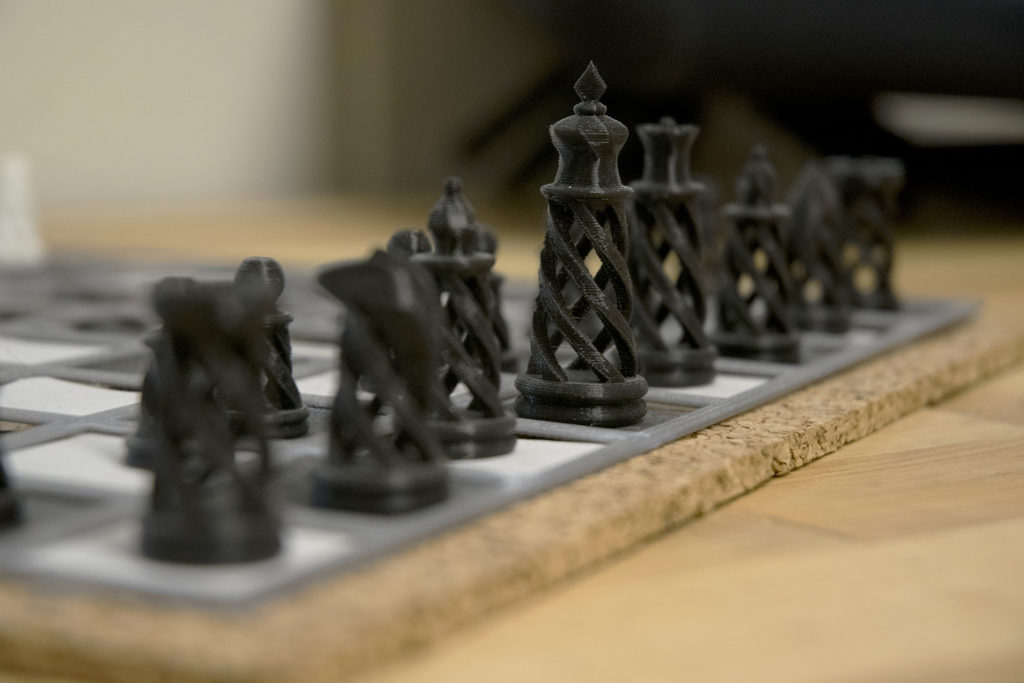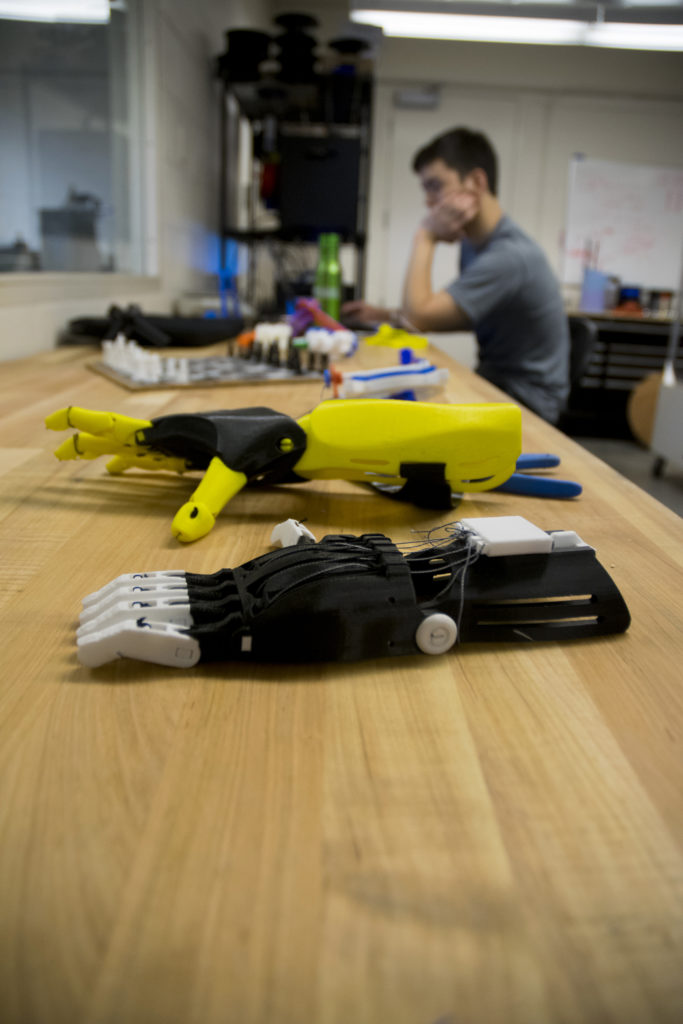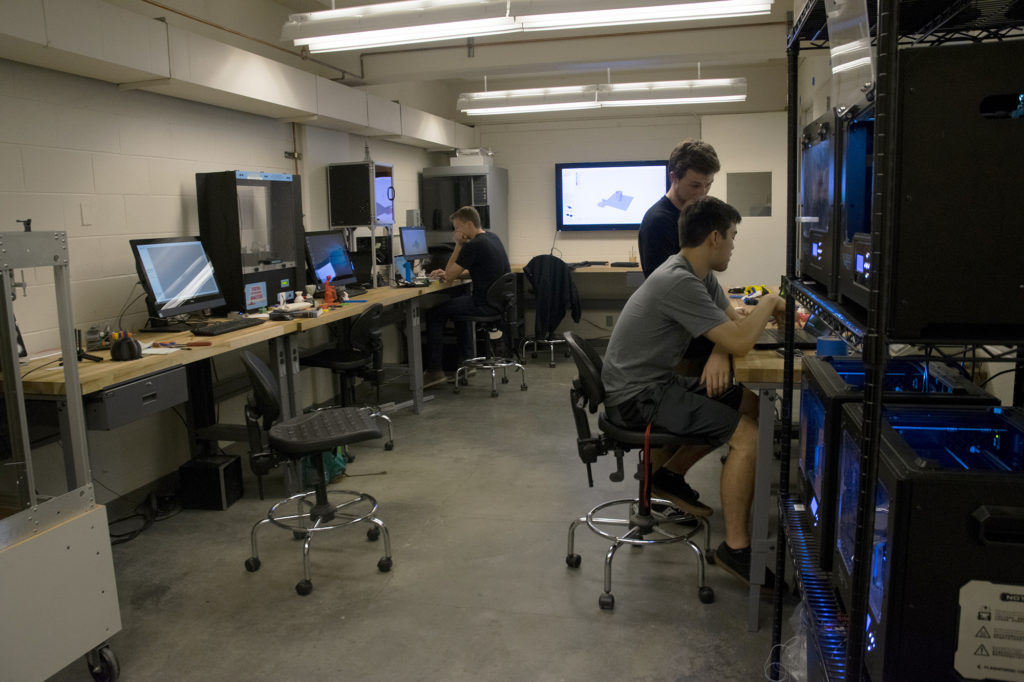Fidget spinners are taking the world by storm. The small toys can be spun between one’s fingers, providing a pleasing sensory experience for the user. They’re so popular for kids of all ages that stores across the globe are selling out, creating a mass market craze for the toys.

Students in the 3D printing club are able to design and create objects in the school’s printing lab.
If you can’t get your hands on one in store, Seattle University’s 3D printing club can print you one within a matter of minutes, along with almost anything else you can think of.
The 3D printing lab is found within the bowels of the Engineering Building, and has printers of all sizes. The lab’s tables are scattered with printed objects, ranging from miniature jet engines and prosthetic hands, to their own 3D-printed trash can.
“I’m actually the biggest fan of the trash can,” said junior mechanical engineering major, and 3D printing club co-president Chris Salsbury. “It’s super simple, and we needed it. It’s the most practical thing we’ve printed. We were like, ‘Oh we don’t have anywhere to throw anything away…’ and eight hours later we did.”
The 3D printing lab was established last June, when senior Alex Bouck, along with Salsbury, spent their summer doing research with mechanical engineering professor Joshua Hamel. Once the summer ended, the two decided they wanted to continue work with 3D printers, and began filing the paperwork to start a club.
In November, the paperwork went through and 3D printing club began. Since then, the club has worked on a number of projects, including cross- disciplinary work with other majors.
“We’ve had art students, business students and biology students in here, and we’ve even done art installations,” said Bouck, the other co-president of 3D printing club. “We’ve also had electrical engineers, which is funny because they have their own lab, but they came to ours,” added Salsbury.
These projects include printing models of the flu virus for biology majors to models of crocodiles and alligators for art majors.

The 3D printing club has been working with a non-profit organization by creating their own prosthetic limbs in the 3D printing lab.
To make these objects, 3D models are rendered on computers, either created by students, or found online on design-sharing websites such as thingiverse.com.
Next, the design is transferred to Simplify3D, which is a modeling software that allows the designer to virtually view the product being printed and adjust settings for each individual print parameter.
“Basically, the program allows you to view the 3D model so you can take it down layer by layer, and see every layer that’s being printed, so you can account for supporting material that needs to be printed,” said sophomore mechanical engineering major Matt Moe. “There’s the thickness of the plastic that it prints and things like that…it’s really specific to what part you’re designing and what sort of size you’re working with.”
One of the projects Moe worked on is with an organization called E-nable, which enlists groups with 3D printers to print out prosthetic hands for those in need.
“It’s basically different designs for a prosthetic hand that we print out, and send it in to the company,” Moe said. “Then they check it, and then we’ll make it for specific people. [They] do custom designs, so that’s a rewarding and fun thing.”
3D printing club has also been enlisted to help out with an art exhibition on campus in the Hedreen Gallery, called “Robots Building Robots.”
“We put one of our printers in the gallery,” Salsbury said. “A man went through Europe and scanned a bunch of ancient busts and statues, and [the artists] put in orders, and we printed them in whatever colors they wanted.”
The largest printer in the lab is called the Gigabot and has a two-foot by two-foot bed for printing objects. The club was able to purchase this printer with a grant provided by Boeing, and since then, the club has received more funds to purchase more printers. “Ultimately we’ve either gotten more grants, or Dr. Hamel has bought some, and we’ve gotten funding from SGSU to build the 3D scanner and buy another printer,” Salsbury said. “We just keep getting more funds, and [we’re] fundraising as well.”

The 3D printing club works on various projects for class, other organizations and simply for fun.
3D printing club’s fundraising efforts have included t-shirts with one of their professors’ face on it—Dr. Frank Shih—as well as various 3D printed objects, such as the aforementioned fidget spinners.
“The biggest thing about 3D printing is that you can have your 3D animations, and you can print them and [then] you have a tangible object that you can have,” Moe said. “You can see what you’ve created, which is really neat.”
As of right now, 3D printing club is open to all students who are interested, although it may become exclusive to engineering majors in the future.
Chris Salsbury is Copy Chief for the Spectator.
Anna may be reached at
akaplan@su-spectator.com







